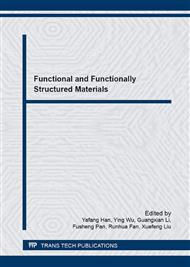p.446
p.454
p.460
p.466
p.472
p.477
p.482
p.489
p.494
Investigation on Power Effect of Gallium-Doped Zinc Oxide Thin Film Semiconductor Performance
Abstract:
Gallium-doped zinc oxide (GZO) thin films were fabricated by radio frequency (RF) magnetron sputtering on glass and silicon substrate at room temperature. The fabrication process, structure, optical properties, and electrical properties of the thin films with different powers (50 W, 70W, and 100 W) were studied to obtain more knowledge about the semiconductor performance. X-ray diffraction (XRD) analysis indicated that the GZO films were polycrystalline and preferred c axis orientation. The average transmittance decreased form 93% to 84% in the visible range, and all the optical band gap was about 3.05 eV when the power increased from 50W to 100W. Simultaneously, the GZO thin film transistors (TFTs) with excellent transfer characteristic prove that GZO thin film is a potential semiconductor material candidate which can be used for the active layer in thin film transistors fabrication.
Info:
Periodical:
Pages:
472-476
Citation:
Online since:
March 2016
Authors:
Price:
Сopyright:
© 2016 Trans Tech Publications Ltd. All Rights Reserved
Share:
Citation:


